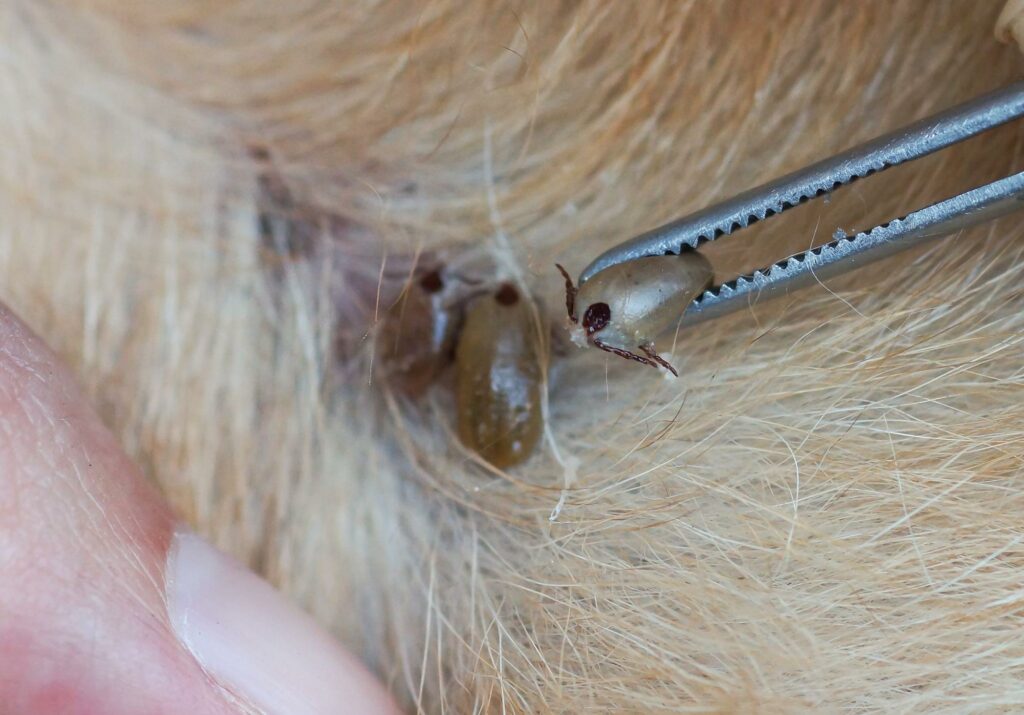Bug bites and insect stings are a commonality for pet owners. Knowing how to recognize, treat and prevent bug bites is essential for owning a dog. It is crucial to focus on prevention, so consulting with your veterinarian to develop a treatment plan is recommended.
Some areas, especially the southern states, can create an unpleasant experience for your pet. Small bumps can appear on the skin after being stung or bitten by an insect, and a life-threatening reaction can occur. Contact your veterinarian if your dog is in severe discomfort or displays breathing issues.

Types of Bites
Knowing what type of bug bit your pet will help your veterinarian determine the best course of action for treatment. There are many more insect varieties not listed below, and however, these are the most common among our canine friends.
Fleas
Once a flea bites your pup, it will lick, chew, or scratch in hopes of lessening the irritation from the bite. Some areas of the body that is prone to bites are the head, neck, groin, perineum, and base of the tail. One bite can cause a reaction all over due to the salvia of the bug.
Ticks
A dog can acquire a tick from brushing against the ground, leaf, branch, grass, or other surfaces. Ticks move slowly on the surface of the skin until they find a spot to bite through layers of skin and draw blood for their meal. A tick can go unnoticed if non-engorged. Once they feed and become engorged, they become more noticeable. Crusting and swelling can occur once the tick is removed or falls off.
Mites
Mites are tiny insects that tunnel deep in the layers of your dog’s skin. The bugs do this to feed and live, and burrowing deep in the skin, creates inflammation and leads to bacteria or yeast infections. The armpits, groin, ears, and areas with little hair are prone to skin lesions from mites.
Mosquitoes
Our pets are keenly aware the moment they get bitten by a mosquito. Sudden licking, scratching, and chewing at the bite site is a typical response to being bitten. Larger areas like the back and flank are susceptible to being bitten because it provides a broad scope for the mosquito to attach. However, the entire body is prone to attack. Your furry friend may itch the spot for minutes or hours, but most likely, there will be no long-term side effects.
Ants
Ants will contact an animal with whatever body part is touching the ground. So if your pup is standing, a bite will occur on the paws. If laying on the ground, more areas are prone to a bite. Localized swelling or pain is the typical reaction. Itching, redness, and lameness are normal responses to ant bites.
Flies
Since flies can land anywhere, bites can happen on any body part. The reactions are typically pain and swelling like fleas and ants without a lingering whole-body effect.
Mobility-compromised, newborn, and older dogs are more susceptible to adverse reactions like itching and swelling. The danger with flies is they could lay eggs in an open sore, and within days the hatched eggs turn into larvae, crawling around the skin and burrowing deeper, causing a bacteria infection.
Bees, Hornets, and Wasps
Like mosquitoes, the sting of a hornet, bee, or wasp is localized in one spot and can happen anywhere on the body. However, a sting from one of these insects releases venom into their body that causes an inflammatory response that can lead to redness, swelling, hives. Some severe reactions include vomiting, diarrhea, stumbling, and low blood pressure for sensitive pets.
Treatment Options
Before you administer anything oral or topical, be sure to call your veterinarian regarding home treatment. Your veterinarian has a wealth of knowledge on what is safe to use and has your dog’s medical chart to reference weight, breed, etc., which may influence their recommendation.
Some dogs may go into anaphylactic shock that requires immediate attention and an injection of steroids. If your furry friend has been bitten by a venomous spider, it may require hospitalization to monitor reactions closely.
Topical
Some treatments can be administered directly on the skin to help with pain, itching, and burning. Cortisone cream, aloe vera, calamine lotion, and cold compresses are some options to help soothe your pup from itching and inflammation. After applying, be sure to monitor so they do not lick off the medicine and ingest it. If your furry friend has a bee sting, you can combine water and baking soda to make a paste to take the burn out, and for a wasp sting, you can mix water and vinegar.
Oral
An antihistamine such as Benadryl can be given to reduce the severity of an allergic reaction. To ensure proper dosage is administered, contact your vet for recommendations. If your dog is on other medications, we recommend you consult your puppy’s doctor before giving them anything orally.
Avoid giving Tylenol, aspirin, or naproxen, as these medications are harmful to your furry friend and potentially fatal.
Collar-based
Many practitioners value a flea and tick collar to kill fleas and ticks that carry diseases quickly, and some even prefer this method over the oral kind. For pet owners that do not want to use spot treatments or tablets, a collar is an excellent option for your best friend.
Flea Bath and Comb
There are many flea bath products on the market for you to choose the best option for your pet. You can also use a mild soap that is safe for your pup. While your dog has fleas, a flea bath should only be needed once a week. Keep a special flea comb on hand to remove fleas and their eggs. Focus on prone areas such as the hind end and tail head.
Tweezers and Credit Card
To remove a tick from your dog, use fine-point tweezers along with even, steady pressure to grab the head. Avoid jerking quickly or grabbing the body of the tick. You might leave toxins or parts of the mouth embedded in the skin by doing this. For a bee stinger left in the skin, avoid using tweezers or your fingers to remove it. Instead, use a credit card to scrape the stinger out.

Prevention of Bites
While it is best to keep your dog inside, there will be times when venturing outdoors is necessary. It is imperative to utilize prevention medicines prescribed by your veterinarian or bought over the counter.
Administer Meds Regularly
One way to stay ahead of what could be a harmful flea or tick issue is to maintain a regular schedule of administering preventative medicine. Most of these medications are to be given monthly and all year round. It’s a common misconception that preventive measures only need to be taken over the warmer months. Adult fleas indeed prefer warmer months. However, they still exist, even during the cold months.
Hire an Exterminator
To minimize the risk of being stung or bitten at your home, have an exterminator treat your home and yard. If you go this route, make sure the products are dog friendly! Safely remove wasp and hornet nests as soon as you see them, and perform spot treatment for pesky bugs.
Avoid Outdoors During Peak Times
Another option to prevent bites is not to go outside during peak times for insects to be out. For example, mosquitos love to swarm at dusk. On the other hand, bees and wasps like to sting mid-morning. Consider the surroundings where you walk and play as well. Swampy and wet spots are breeding grounds for mosquitoes and other annoying insects. Avoid tall grass and weeds.
Now you know the types of insects that can harm your family pet and how you can treat them. Don’t be afraid to go outside and explore with your dog. You are armed with an arsenal of knowledge to help you plan an outdoor excursion and the symptoms to look out for if your pup happens to get bitten or stung.










